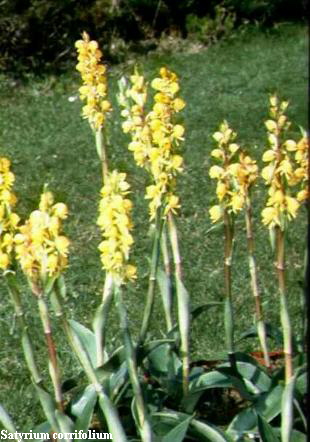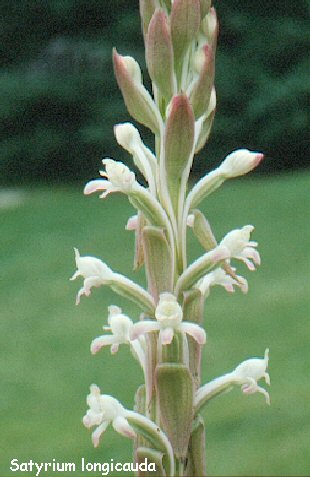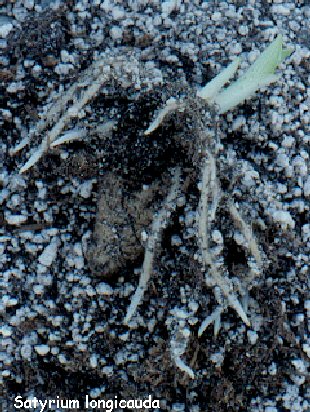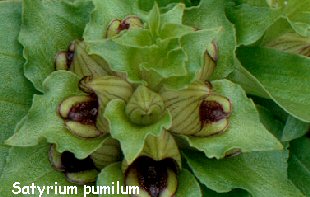Comments to the offered plants:

Satyrium corrifolium. A tall, beautiful yellow flowerstem and fleshy leaves halfway erect on the ground. Wintergrowing and summer dormant. Frost hardy up to -2°C.


Satyrium longicauda. Summer rain area of South-Africa. Plants start to grow in April (Central-Europe). Garden culture during summer is favourable. Ether planted in the garden or in a suitable pot. Bring inside before the first frosts in autumn and overwinter dry and cool. Flowers in July and August. In flowering sized plants the old tuber overwinters and will flower in the next summer (large shoot on the picture above). Flowering sized plants therefore show 2 shoots on 2 tubers (the old tuber and the new tuber).

Satyrium pumilum. A strange plant from dry inland regions of the South-West-Cape of South-Africa. Easy in culture and surprisingly tolerant to wet conditions. Summerdormant. Leaves and flowers flat on the ground. Frost hardy to -5°C. Flowers scented of putrid meat.
Distribution:
More than 100 species, most are endemic to southern Africa, extending
to the highlands of tropical Africa. 2 are found in Asia and 5 species
occur in Madagascar.
Description:
Flower stems 1 to 130cm high, with 1 to 6 fleshy leaves. Leaves sometimes
absent or on a seperate stem. Few to numerous flowers, not resupinate,
green or colourful . Labellum twospurred and upermost. Sepals and petals
often fused to the labellum.
Culture:
Satyrium are fairly easy to grow. Some are summer growing, others
are winter growing and summer dormant. Most species flower in spring or
summer. Summer growing species can be cultured outside in the garden during
the warm period. Colect the tuber before the onset of frosts and store
in dry conditions in the fridge.Winter growing species are frost hardy
up to -4°C. Culture as sunny as possible. Regular watering during the
growing period is essential. Fertilize monthly with 0.3g/l until flowering.
Reduce watering gradually later in the season and stop as the leaves die
back. Completely dry during dormancy. Occasionally a light spray of water
for small plants and seedlings to prevent dehydration. If grown inside,
move plants temporary outside in late summer as cool nights and some rain
will stimulate plants into the new growing season.
Recommended potting mixes:
80% Seramis or fine to medium grade Perlite. 20% organic components.
Favourable are fermented or N-impregnated wood shavings or saw dust. (Toresa
has given good results.) No peat. Spagnum moss is suitable. Substrates
have to be well draining with a pH of 5 to 6.
Further reading:
Wild orchids of Southern Africa. J. Stuart, H.P. Linder, E.A.
Schelpe, A.V. Hall, 1982. Macmillan South Africa.(Publishers)(Pty)Ltd.
ISBN 0 86954 070 X.
Growing South African indigenous orchids. Karsten, B. Woodrich,
1997.Balkema ISBN 90 5410 650 6.
Orchids of Kenia. Joyce Stuart, 1996. St Pauls Bibliographies,Winchester.ISBN
1 873040 28 8.
Orchids of Southern Africa. H.P. Linder and H. Kurzweil, 1999.
A.A. Balkema/Rotterdam/Brookfield. ISBN 90 5410 4457.